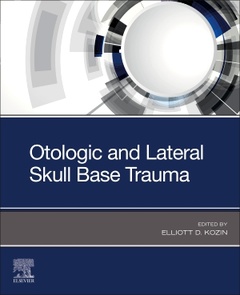Otologic and Lateral Skull Base Trauma
Coordonnateur : Kozin Elliott D.

Covers the epidemiology, basic pathophysiology, diagnostic evaluation, and treatment of temporal bone trauma, including complex injuries of the lateral skull base.
Contains multiple chapters co-written by leading speciality experts: imaging of the temporal bone and brain following head injury (co-written by leading neuroradiologists); facial nerve injury management (co-written by leading facial nerve specialists); vascular injury management (co-written by leading neurosurgeons); soft tissue repair of auricular trauma (co-written by leading facial plastic surgeons); acoustic overexposure and blast injury management (co-written by leading experts in noise-induced hearing loss); rehabilitation following head trauma (co-written by leading physical medicine and rehabilitation providers, occupational therapists, and physical therapists) and more.
Includes detailed coverage of labyrinthine concussion diagnosis and management, medical and surgical management of temporal bone fractures, conductive and sensorineural hearing loss and rehabilitation after head injury, balance disturbance after head injury, and much more.
Discusses animal models of head injury and current research, with a focus on the auditory system.
Consolidates today's available information on this timely topic into a single, convenient resource.
Chapter 1: Epidemiology of lateral skull base and traumatic brain injury in the United States. The chapter will
provide an epidemiologic overview of head injury, including traumatic brain injury and temporal bone fractures,
as it relates to the otolaryngologist.
Chapter 2: Basic pathophysiology of auditory dysfunction following head injury. The chapter will provide an
overview of the physiologic changes that may occur after head injury. There will be a focus on both peripheral
and central auditory pathway pathology.
Chapter 3: Imaging of the temporal bone and brain following head injury. The chapter will focus on computed
tomography and magnetic resonance imaging -based imaging of the lateral skull base and brain following head
injury. Focus will be given to temporal bone fractures, vascular injuries, and cerebrospinal fluid leaks. (This
chapter will be co-written by leading neuroradiologists.)
Chapter 4: Labyrinthine concussion diagnosis and management. The chapter will discuss the pathology,
diagnosis, and management of labyrinthine concussion. There will be a focus on auditory changes.
Chapter 5: Medical and surgical management of temporal bone fractures. The chapter will provide an in-depth
discussion of the diagnosis, as well as medical and surgical medical management of temporal bone fractures.
Chapter 6: Facial nerve injury management following temporal bone fractures. The chapter will provide an in-depth discussion of the diagnosis, as well as medical and surgical medical management of facial nerve injury.
(This chapter will be co-written by leading facial nerve specialists.)
Chapter 7: Cerebrospinal fluid leak management following temporal bone fractures. The chapter will provide an
in-depth discussion of the diagnosis, as well as medical and surgical medical management of cerebrospinal
fluid leaks.
Chapter 8: Vascular injury management following temporal bone fractures. The chapter will provide an in-depth
discussion of the diagnosis, as well as medical and surgical medical management of vascular injuries of the
temporal bone following temporal bone fractures. (This chapter will be co-written by leading neurosurgeons.)
Chapter 9: Conductive hearing loss and rehabilitation after head injury. The chapter will discuss conductive
hearing loss, such as ossicular chain disruption, following head injury and potential auditory rehabilitation
options, including hearing amplification and ossicular chain reconstruction.
Chapter 10: Sensorineural hearing loss and rehabilitation after head injury. The chapter will discuss
sensorineural hearing loss following head injury and potential auditory rehabilitation options, including cochlear
implantation and auditory brainstem implantation.
Chapter 11: Soft tissue repair of auricular trauma. The chapter will focus on soft tissue trauma of the auricle
and surgical repair. (This chapter will be co-written by leading facial plastic surgeons.)
Chapter 12: Acoustic overexposure and blast injury management. The chapter will focus on noise exposure, as
well as blast injury. Physiology and treatment will be emphasized. Cochlear synaptopathy will also be
discussed. (This chapter will be co-written by leading experts in noise-induced hearing loss.)
Chapter 13: Animal models of traumatic brain injury and contemporary research. The chapter will focus on
current research approaches on traumatic brain injury as it pertains to the auditory system. (This chapter will
be co-written by leading investigators in traumatic brain injury research.)
Date de parution : 10-2023
Ouvrage de 266 p.
19x23.4 cm
Mots-clés :
Animal model; Auditory dysfunction; Auricular hematoma; Auricular reconstruction; Auricular repair; Auricular trauma; Autologous rib graft; Blast injury; Blast overpressure; Blunt cerebrovascular injury; Cavernous-carotid fistula; Computational model; Cone beam CT; CSF leak; Dizziness; Ear lobe repair; Electrodiagnostic testing; Epidural hematoma; Facial nerve injury; Facial weakness; Fistula; Fracture pattern; Head injury epidemiology; Head trauma; Hearing loss; Helical rim advancement; Human temporal bone study; Hyperacusis; Imbalance; Labyrinthine concussion; Lateral skull base injury epidemiology; Magnetic resonance imaging; Multidetector CT; Neurologic deficits; Otic capsule disrupting; Otic capsule sparing; Otology; Pathophysiology; Perforation; Physiology; Postauricular flap; Regeneration; Rehabilitation; Sensorineural hearing loss; Surgical decompression; Synaptopathy; Temporal bone fracture



